Philosophy Essay: ATS2867, Ridley, Lloyd, and Female Orgasm Debate
VerifiedAdded on 2023/04/21
|7
|3735
|156
Essay
AI Summary
This essay, submitted for the ATS2867 unit at Monash University, delves into the contrasting theories of Matt Ridley and Elizabeth Lloyd concerning female orgasm. It begins by defining sexual arousal and its biological and psychological components, highlighting the historical context of patriarchal influence on the understanding of female sexuality. The essay provides an overview of Ridley's utilitarian perspective, emphasizing the role of sexual attraction in procreation and how societal structures have shaped gender dynamics. The essay explores whether Lloyd would criticize Ridley’s ‘Emma Bovary’ theory, and whether it can be considered pseudoscientific. The essay concludes with an analysis of the potential criticisms Lloyd might level against Ridley's views on female orgasm and its evolution, providing a comprehensive comparison of their differing perspectives. The essay addresses the question set, presents a clear argument, demonstrates a strong understanding of the primary texts, and effectively uses secondary sources to support its claims.
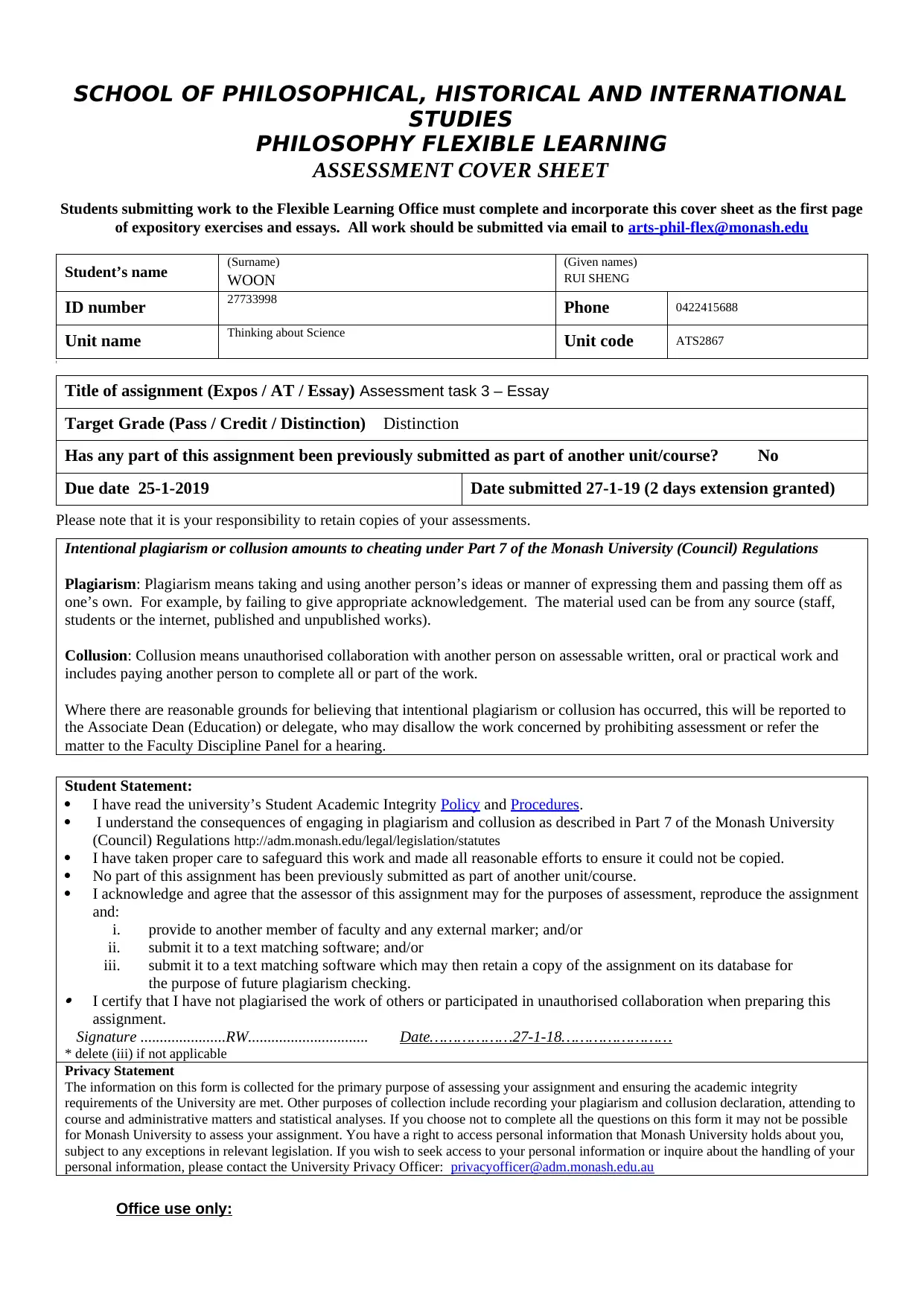
SCHOOL OF PHILOSOPHICAL, HISTORICAL AND INTERNATIONAL
STUDIES
PHILOSOPHY FLEXIBLE LEARNING
ASSESSMENT COVER SHEET
Students submitting work to the Flexible Learning Office must complete and incorporate this cover sheet as the first page
of expository exercises and essays. All work should be submitted via email to arts-phil-flex@monash.edu
Student’s name (Surname)
WOON
(Given names)
RUI SHENG
ID number 27733998 Phone 0422415688
Unit name Thinking about Science Unit code ATS2867
t
Title of assignment (Expos / AT / Essay) Assessment task 3 – Essay
Target Grade (Pass / Credit / Distinction) Distinction
Has any part of this assignment been previously submitted as part of another unit/course? No
Due date 25-1-2019 Date submitted 27-1-19 (2 days extension granted)
Please note that it is your responsibility to retain copies of your assessments.
Intentional plagiarism or collusion amounts to cheating under Part 7 of the Monash University (Council) Regulations
Plagiarism: Plagiarism means taking and using another person’s ideas or manner of expressing them and passing them off as
one’s own. For example, by failing to give appropriate acknowledgement. The material used can be from any source (staff,
students or the internet, published and unpublished works).
Collusion: Collusion means unauthorised collaboration with another person on assessable written, oral or practical work and
includes paying another person to complete all or part of the work.
Where there are reasonable grounds for believing that intentional plagiarism or collusion has occurred, this will be reported to
the Associate Dean (Education) or delegate, who may disallow the work concerned by prohibiting assessment or refer the
matter to the Faculty Discipline Panel for a hearing.
Student Statement:
I have read the university’s Student Academic Integrity Policy and Procedures.
I understand the consequences of engaging in plagiarism and collusion as described in Part 7 of the Monash University
(Council) Regulations http://adm.monash.edu/legal/legislation/statutes
I have taken proper care to safeguard this work and made all reasonable efforts to ensure it could not be copied.
No part of this assignment has been previously submitted as part of another unit/course.
I acknowledge and agree that the assessor of this assignment may for the purposes of assessment, reproduce the assignment
and:
i. provide to another member of faculty and any external marker; and/or
ii. submit it to a text matching software; and/or
iii. submit it to a text matching software which may then retain a copy of the assignment on its database for
the purpose of future plagiarism checking. I certify that I have not plagiarised the work of others or participated in unauthorised collaboration when preparing this
assignment.
Signature ......................RW............................... Date………………27-1-18……………………
* delete (iii) if not applicable
Privacy Statement
The information on this form is collected for the primary purpose of assessing your assignment and ensuring the academic integrity
requirements of the University are met. Other purposes of collection include recording your plagiarism and collusion declaration, attending to
course and administrative matters and statistical analyses. If you choose not to complete all the questions on this form it may not be possible
for Monash University to assess your assignment. You have a right to access personal information that Monash University holds about you,
subject to any exceptions in relevant legislation. If you wish to seek access to your personal information or inquire about the handling of your
personal information, please contact the University Privacy Officer: privacyofficer@adm.monash.edu.au
Office use only:
STUDIES
PHILOSOPHY FLEXIBLE LEARNING
ASSESSMENT COVER SHEET
Students submitting work to the Flexible Learning Office must complete and incorporate this cover sheet as the first page
of expository exercises and essays. All work should be submitted via email to arts-phil-flex@monash.edu
Student’s name (Surname)
WOON
(Given names)
RUI SHENG
ID number 27733998 Phone 0422415688
Unit name Thinking about Science Unit code ATS2867
t
Title of assignment (Expos / AT / Essay) Assessment task 3 – Essay
Target Grade (Pass / Credit / Distinction) Distinction
Has any part of this assignment been previously submitted as part of another unit/course? No
Due date 25-1-2019 Date submitted 27-1-19 (2 days extension granted)
Please note that it is your responsibility to retain copies of your assessments.
Intentional plagiarism or collusion amounts to cheating under Part 7 of the Monash University (Council) Regulations
Plagiarism: Plagiarism means taking and using another person’s ideas or manner of expressing them and passing them off as
one’s own. For example, by failing to give appropriate acknowledgement. The material used can be from any source (staff,
students or the internet, published and unpublished works).
Collusion: Collusion means unauthorised collaboration with another person on assessable written, oral or practical work and
includes paying another person to complete all or part of the work.
Where there are reasonable grounds for believing that intentional plagiarism or collusion has occurred, this will be reported to
the Associate Dean (Education) or delegate, who may disallow the work concerned by prohibiting assessment or refer the
matter to the Faculty Discipline Panel for a hearing.
Student Statement:
I have read the university’s Student Academic Integrity Policy and Procedures.
I understand the consequences of engaging in plagiarism and collusion as described in Part 7 of the Monash University
(Council) Regulations http://adm.monash.edu/legal/legislation/statutes
I have taken proper care to safeguard this work and made all reasonable efforts to ensure it could not be copied.
No part of this assignment has been previously submitted as part of another unit/course.
I acknowledge and agree that the assessor of this assignment may for the purposes of assessment, reproduce the assignment
and:
i. provide to another member of faculty and any external marker; and/or
ii. submit it to a text matching software; and/or
iii. submit it to a text matching software which may then retain a copy of the assignment on its database for
the purpose of future plagiarism checking. I certify that I have not plagiarised the work of others or participated in unauthorised collaboration when preparing this
assignment.
Signature ......................RW............................... Date………………27-1-18……………………
* delete (iii) if not applicable
Privacy Statement
The information on this form is collected for the primary purpose of assessing your assignment and ensuring the academic integrity
requirements of the University are met. Other purposes of collection include recording your plagiarism and collusion declaration, attending to
course and administrative matters and statistical analyses. If you choose not to complete all the questions on this form it may not be possible
for Monash University to assess your assignment. You have a right to access personal information that Monash University holds about you,
subject to any exceptions in relevant legislation. If you wish to seek access to your personal information or inquire about the handling of your
personal information, please contact the University Privacy Officer: privacyofficer@adm.monash.edu.au
Office use only:
Paraphrase This Document
Need a fresh take? Get an instant paraphrase of this document with our AI Paraphraser
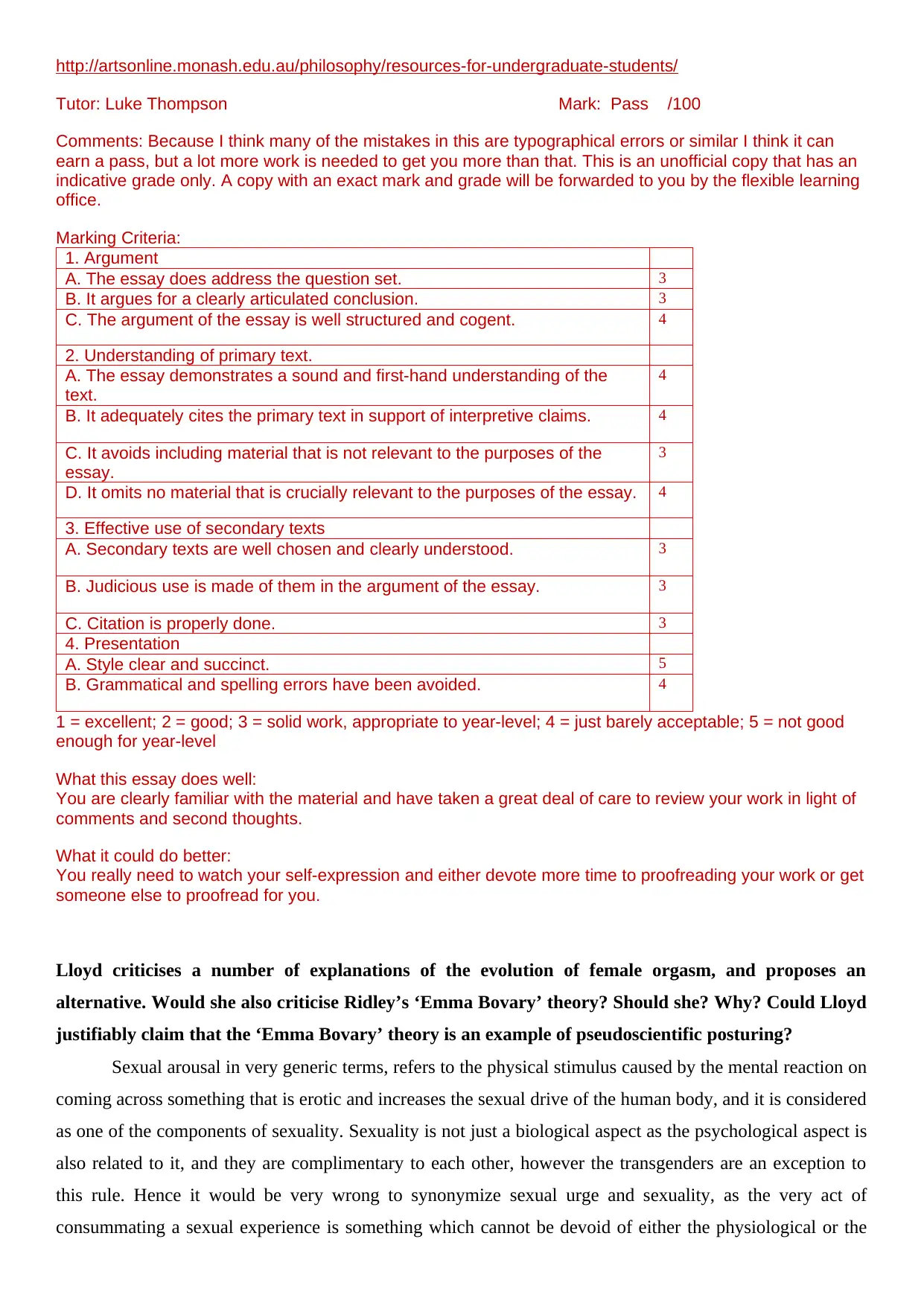
http://artsonline.monash.edu.au/philosophy/resources-for-undergraduate-students/
Tutor: Luke Thompson Mark: Pass /100
Comments: Because I think many of the mistakes in this are typographical errors or similar I think it can
earn a pass, but a lot more work is needed to get you more than that. This is an unofficial copy that has an
indicative grade only. A copy with an exact mark and grade will be forwarded to you by the flexible learning
office.
Marking Criteria:
1. Argument
A. The essay does address the question set. 3
B. It argues for a clearly articulated conclusion. 3
C. The argument of the essay is well structured and cogent. 4
2. Understanding of primary text.
A. The essay demonstrates a sound and first-hand understanding of the
text.
4
B. It adequately cites the primary text in support of interpretive claims. 4
C. It avoids including material that is not relevant to the purposes of the
essay.
3
D. It omits no material that is crucially relevant to the purposes of the essay. 4
3. Effective use of secondary texts
A. Secondary texts are well chosen and clearly understood. 3
B. Judicious use is made of them in the argument of the essay. 3
C. Citation is properly done. 3
4. Presentation
A. Style clear and succinct. 5
B. Grammatical and spelling errors have been avoided. 4
1 = excellent; 2 = good; 3 = solid work, appropriate to year-level; 4 = just barely acceptable; 5 = not good
enough for year-level
What this essay does well:
You are clearly familiar with the material and have taken a great deal of care to review your work in light of
comments and second thoughts.
What it could do better:
You really need to watch your self-expression and either devote more time to proofreading your work or get
someone else to proofread for you.
Lloyd criticises a number of explanations of the evolution of female orgasm, and proposes an
alternative. Would she also criticise Ridley’s ‘Emma Bovary’ theory? Should she? Why? Could Lloyd
justifiably claim that the ‘Emma Bovary’ theory is an example of pseudoscientific posturing?
Sexual arousal in very generic terms, refers to the physical stimulus caused by the mental reaction on
coming across something that is erotic and increases the sexual drive of the human body, and it is considered
as one of the components of sexuality. Sexuality is not just a biological aspect as the psychological aspect is
also related to it, and they are complimentary to each other, however the transgenders are an exception to
this rule. Hence it would be very wrong to synonymize sexual urge and sexuality, as the very act of
consummating a sexual experience is something which cannot be devoid of either the physiological or the
Tutor: Luke Thompson Mark: Pass /100
Comments: Because I think many of the mistakes in this are typographical errors or similar I think it can
earn a pass, but a lot more work is needed to get you more than that. This is an unofficial copy that has an
indicative grade only. A copy with an exact mark and grade will be forwarded to you by the flexible learning
office.
Marking Criteria:
1. Argument
A. The essay does address the question set. 3
B. It argues for a clearly articulated conclusion. 3
C. The argument of the essay is well structured and cogent. 4
2. Understanding of primary text.
A. The essay demonstrates a sound and first-hand understanding of the
text.
4
B. It adequately cites the primary text in support of interpretive claims. 4
C. It avoids including material that is not relevant to the purposes of the
essay.
3
D. It omits no material that is crucially relevant to the purposes of the essay. 4
3. Effective use of secondary texts
A. Secondary texts are well chosen and clearly understood. 3
B. Judicious use is made of them in the argument of the essay. 3
C. Citation is properly done. 3
4. Presentation
A. Style clear and succinct. 5
B. Grammatical and spelling errors have been avoided. 4
1 = excellent; 2 = good; 3 = solid work, appropriate to year-level; 4 = just barely acceptable; 5 = not good
enough for year-level
What this essay does well:
You are clearly familiar with the material and have taken a great deal of care to review your work in light of
comments and second thoughts.
What it could do better:
You really need to watch your self-expression and either devote more time to proofreading your work or get
someone else to proofread for you.
Lloyd criticises a number of explanations of the evolution of female orgasm, and proposes an
alternative. Would she also criticise Ridley’s ‘Emma Bovary’ theory? Should she? Why? Could Lloyd
justifiably claim that the ‘Emma Bovary’ theory is an example of pseudoscientific posturing?
Sexual arousal in very generic terms, refers to the physical stimulus caused by the mental reaction on
coming across something that is erotic and increases the sexual drive of the human body, and it is considered
as one of the components of sexuality. Sexuality is not just a biological aspect as the psychological aspect is
also related to it, and they are complimentary to each other, however the transgenders are an exception to
this rule. Hence it would be very wrong to synonymize sexual urge and sexuality, as the very act of
consummating a sexual experience is something which cannot be devoid of either the physiological or the
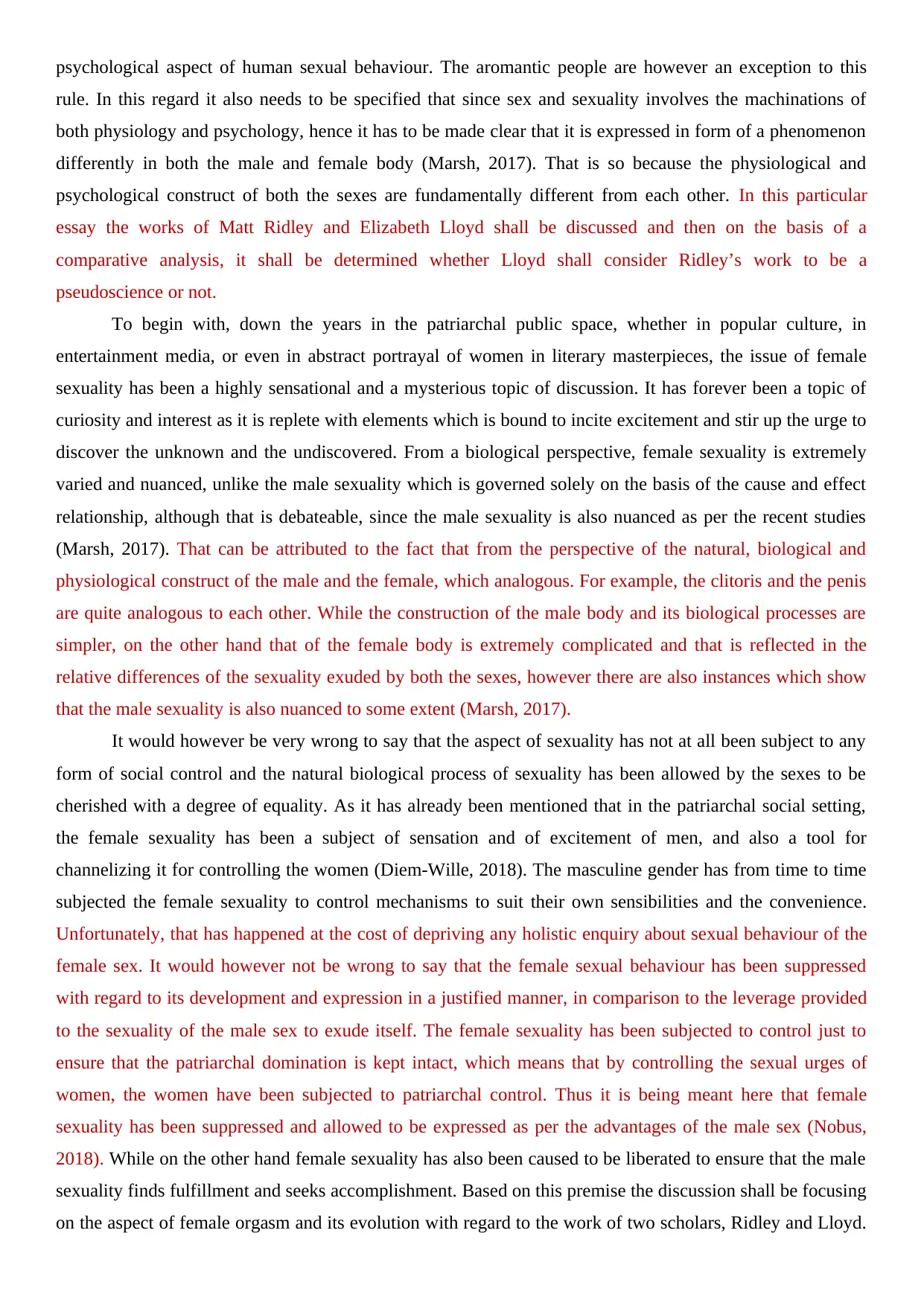
psychological aspect of human sexual behaviour. The aromantic people are however an exception to this
rule. In this regard it also needs to be specified that since sex and sexuality involves the machinations of
both physiology and psychology, hence it has to be made clear that it is expressed in form of a phenomenon
differently in both the male and female body (Marsh, 2017). That is so because the physiological and
psychological construct of both the sexes are fundamentally different from each other. In this particular
essay the works of Matt Ridley and Elizabeth Lloyd shall be discussed and then on the basis of a
comparative analysis, it shall be determined whether Lloyd shall consider Ridley’s work to be a
pseudoscience or not.
To begin with, down the years in the patriarchal public space, whether in popular culture, in
entertainment media, or even in abstract portrayal of women in literary masterpieces, the issue of female
sexuality has been a highly sensational and a mysterious topic of discussion. It has forever been a topic of
curiosity and interest as it is replete with elements which is bound to incite excitement and stir up the urge to
discover the unknown and the undiscovered. From a biological perspective, female sexuality is extremely
varied and nuanced, unlike the male sexuality which is governed solely on the basis of the cause and effect
relationship, although that is debateable, since the male sexuality is also nuanced as per the recent studies
(Marsh, 2017). That can be attributed to the fact that from the perspective of the natural, biological and
physiological construct of the male and the female, which analogous. For example, the clitoris and the penis
are quite analogous to each other. While the construction of the male body and its biological processes are
simpler, on the other hand that of the female body is extremely complicated and that is reflected in the
relative differences of the sexuality exuded by both the sexes, however there are also instances which show
that the male sexuality is also nuanced to some extent (Marsh, 2017).
It would however be very wrong to say that the aspect of sexuality has not at all been subject to any
form of social control and the natural biological process of sexuality has been allowed by the sexes to be
cherished with a degree of equality. As it has already been mentioned that in the patriarchal social setting,
the female sexuality has been a subject of sensation and of excitement of men, and also a tool for
channelizing it for controlling the women (Diem-Wille, 2018). The masculine gender has from time to time
subjected the female sexuality to control mechanisms to suit their own sensibilities and the convenience.
Unfortunately, that has happened at the cost of depriving any holistic enquiry about sexual behaviour of the
female sex. It would however not be wrong to say that the female sexual behaviour has been suppressed
with regard to its development and expression in a justified manner, in comparison to the leverage provided
to the sexuality of the male sex to exude itself. The female sexuality has been subjected to control just to
ensure that the patriarchal domination is kept intact, which means that by controlling the sexual urges of
women, the women have been subjected to patriarchal control. Thus it is being meant here that female
sexuality has been suppressed and allowed to be expressed as per the advantages of the male sex (Nobus,
2018). While on the other hand female sexuality has also been caused to be liberated to ensure that the male
sexuality finds fulfillment and seeks accomplishment. Based on this premise the discussion shall be focusing
on the aspect of female orgasm and its evolution with regard to the work of two scholars, Ridley and Lloyd.
rule. In this regard it also needs to be specified that since sex and sexuality involves the machinations of
both physiology and psychology, hence it has to be made clear that it is expressed in form of a phenomenon
differently in both the male and female body (Marsh, 2017). That is so because the physiological and
psychological construct of both the sexes are fundamentally different from each other. In this particular
essay the works of Matt Ridley and Elizabeth Lloyd shall be discussed and then on the basis of a
comparative analysis, it shall be determined whether Lloyd shall consider Ridley’s work to be a
pseudoscience or not.
To begin with, down the years in the patriarchal public space, whether in popular culture, in
entertainment media, or even in abstract portrayal of women in literary masterpieces, the issue of female
sexuality has been a highly sensational and a mysterious topic of discussion. It has forever been a topic of
curiosity and interest as it is replete with elements which is bound to incite excitement and stir up the urge to
discover the unknown and the undiscovered. From a biological perspective, female sexuality is extremely
varied and nuanced, unlike the male sexuality which is governed solely on the basis of the cause and effect
relationship, although that is debateable, since the male sexuality is also nuanced as per the recent studies
(Marsh, 2017). That can be attributed to the fact that from the perspective of the natural, biological and
physiological construct of the male and the female, which analogous. For example, the clitoris and the penis
are quite analogous to each other. While the construction of the male body and its biological processes are
simpler, on the other hand that of the female body is extremely complicated and that is reflected in the
relative differences of the sexuality exuded by both the sexes, however there are also instances which show
that the male sexuality is also nuanced to some extent (Marsh, 2017).
It would however be very wrong to say that the aspect of sexuality has not at all been subject to any
form of social control and the natural biological process of sexuality has been allowed by the sexes to be
cherished with a degree of equality. As it has already been mentioned that in the patriarchal social setting,
the female sexuality has been a subject of sensation and of excitement of men, and also a tool for
channelizing it for controlling the women (Diem-Wille, 2018). The masculine gender has from time to time
subjected the female sexuality to control mechanisms to suit their own sensibilities and the convenience.
Unfortunately, that has happened at the cost of depriving any holistic enquiry about sexual behaviour of the
female sex. It would however not be wrong to say that the female sexual behaviour has been suppressed
with regard to its development and expression in a justified manner, in comparison to the leverage provided
to the sexuality of the male sex to exude itself. The female sexuality has been subjected to control just to
ensure that the patriarchal domination is kept intact, which means that by controlling the sexual urges of
women, the women have been subjected to patriarchal control. Thus it is being meant here that female
sexuality has been suppressed and allowed to be expressed as per the advantages of the male sex (Nobus,
2018). While on the other hand female sexuality has also been caused to be liberated to ensure that the male
sexuality finds fulfillment and seeks accomplishment. Based on this premise the discussion shall be focusing
on the aspect of female orgasm and its evolution with regard to the work of two scholars, Ridley and Lloyd.
⊘ This is a preview!⊘
Do you want full access?
Subscribe today to unlock all pages.

Trusted by 1+ million students worldwide
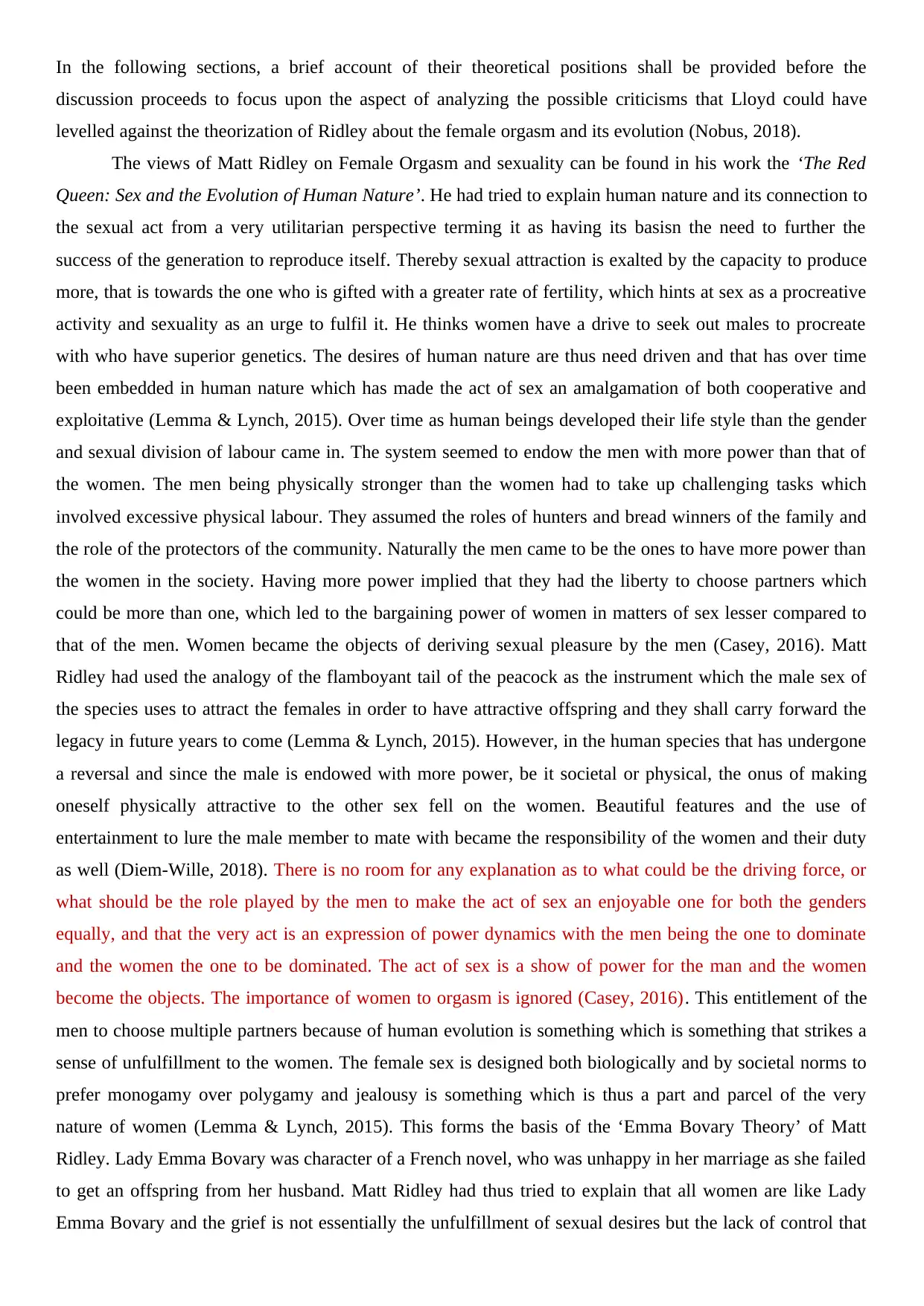
In the following sections, a brief account of their theoretical positions shall be provided before the
discussion proceeds to focus upon the aspect of analyzing the possible criticisms that Lloyd could have
levelled against the theorization of Ridley about the female orgasm and its evolution (Nobus, 2018).
The views of Matt Ridley on Female Orgasm and sexuality can be found in his work the ‘The Red
Queen: Sex and the Evolution of Human Nature’. He had tried to explain human nature and its connection to
the sexual act from a very utilitarian perspective terming it as having its basisn the need to further the
success of the generation to reproduce itself. Thereby sexual attraction is exalted by the capacity to produce
more, that is towards the one who is gifted with a greater rate of fertility, which hints at sex as a procreative
activity and sexuality as an urge to fulfil it. He thinks women have a drive to seek out males to procreate
with who have superior genetics. The desires of human nature are thus need driven and that has over time
been embedded in human nature which has made the act of sex an amalgamation of both cooperative and
exploitative (Lemma & Lynch, 2015). Over time as human beings developed their life style than the gender
and sexual division of labour came in. The system seemed to endow the men with more power than that of
the women. The men being physically stronger than the women had to take up challenging tasks which
involved excessive physical labour. They assumed the roles of hunters and bread winners of the family and
the role of the protectors of the community. Naturally the men came to be the ones to have more power than
the women in the society. Having more power implied that they had the liberty to choose partners which
could be more than one, which led to the bargaining power of women in matters of sex lesser compared to
that of the men. Women became the objects of deriving sexual pleasure by the men (Casey, 2016). Matt
Ridley had used the analogy of the flamboyant tail of the peacock as the instrument which the male sex of
the species uses to attract the females in order to have attractive offspring and they shall carry forward the
legacy in future years to come (Lemma & Lynch, 2015). However, in the human species that has undergone
a reversal and since the male is endowed with more power, be it societal or physical, the onus of making
oneself physically attractive to the other sex fell on the women. Beautiful features and the use of
entertainment to lure the male member to mate with became the responsibility of the women and their duty
as well (Diem-Wille, 2018). There is no room for any explanation as to what could be the driving force, or
what should be the role played by the men to make the act of sex an enjoyable one for both the genders
equally, and that the very act is an expression of power dynamics with the men being the one to dominate
and the women the one to be dominated. The act of sex is a show of power for the man and the women
become the objects. The importance of women to orgasm is ignored (Casey, 2016). This entitlement of the
men to choose multiple partners because of human evolution is something which is something that strikes a
sense of unfulfillment to the women. The female sex is designed both biologically and by societal norms to
prefer monogamy over polygamy and jealousy is something which is thus a part and parcel of the very
nature of women (Lemma & Lynch, 2015). This forms the basis of the ‘Emma Bovary Theory’ of Matt
Ridley. Lady Emma Bovary was character of a French novel, who was unhappy in her marriage as she failed
to get an offspring from her husband. Matt Ridley had thus tried to explain that all women are like Lady
Emma Bovary and the grief is not essentially the unfulfillment of sexual desires but the lack of control that
discussion proceeds to focus upon the aspect of analyzing the possible criticisms that Lloyd could have
levelled against the theorization of Ridley about the female orgasm and its evolution (Nobus, 2018).
The views of Matt Ridley on Female Orgasm and sexuality can be found in his work the ‘The Red
Queen: Sex and the Evolution of Human Nature’. He had tried to explain human nature and its connection to
the sexual act from a very utilitarian perspective terming it as having its basisn the need to further the
success of the generation to reproduce itself. Thereby sexual attraction is exalted by the capacity to produce
more, that is towards the one who is gifted with a greater rate of fertility, which hints at sex as a procreative
activity and sexuality as an urge to fulfil it. He thinks women have a drive to seek out males to procreate
with who have superior genetics. The desires of human nature are thus need driven and that has over time
been embedded in human nature which has made the act of sex an amalgamation of both cooperative and
exploitative (Lemma & Lynch, 2015). Over time as human beings developed their life style than the gender
and sexual division of labour came in. The system seemed to endow the men with more power than that of
the women. The men being physically stronger than the women had to take up challenging tasks which
involved excessive physical labour. They assumed the roles of hunters and bread winners of the family and
the role of the protectors of the community. Naturally the men came to be the ones to have more power than
the women in the society. Having more power implied that they had the liberty to choose partners which
could be more than one, which led to the bargaining power of women in matters of sex lesser compared to
that of the men. Women became the objects of deriving sexual pleasure by the men (Casey, 2016). Matt
Ridley had used the analogy of the flamboyant tail of the peacock as the instrument which the male sex of
the species uses to attract the females in order to have attractive offspring and they shall carry forward the
legacy in future years to come (Lemma & Lynch, 2015). However, in the human species that has undergone
a reversal and since the male is endowed with more power, be it societal or physical, the onus of making
oneself physically attractive to the other sex fell on the women. Beautiful features and the use of
entertainment to lure the male member to mate with became the responsibility of the women and their duty
as well (Diem-Wille, 2018). There is no room for any explanation as to what could be the driving force, or
what should be the role played by the men to make the act of sex an enjoyable one for both the genders
equally, and that the very act is an expression of power dynamics with the men being the one to dominate
and the women the one to be dominated. The act of sex is a show of power for the man and the women
become the objects. The importance of women to orgasm is ignored (Casey, 2016). This entitlement of the
men to choose multiple partners because of human evolution is something which is something that strikes a
sense of unfulfillment to the women. The female sex is designed both biologically and by societal norms to
prefer monogamy over polygamy and jealousy is something which is thus a part and parcel of the very
nature of women (Lemma & Lynch, 2015). This forms the basis of the ‘Emma Bovary Theory’ of Matt
Ridley. Lady Emma Bovary was character of a French novel, who was unhappy in her marriage as she failed
to get an offspring from her husband. Matt Ridley had thus tried to explain that all women are like Lady
Emma Bovary and the grief is not essentially the unfulfillment of sexual desires but the lack of control that
Paraphrase This Document
Need a fresh take? Get an instant paraphrase of this document with our AI Paraphraser
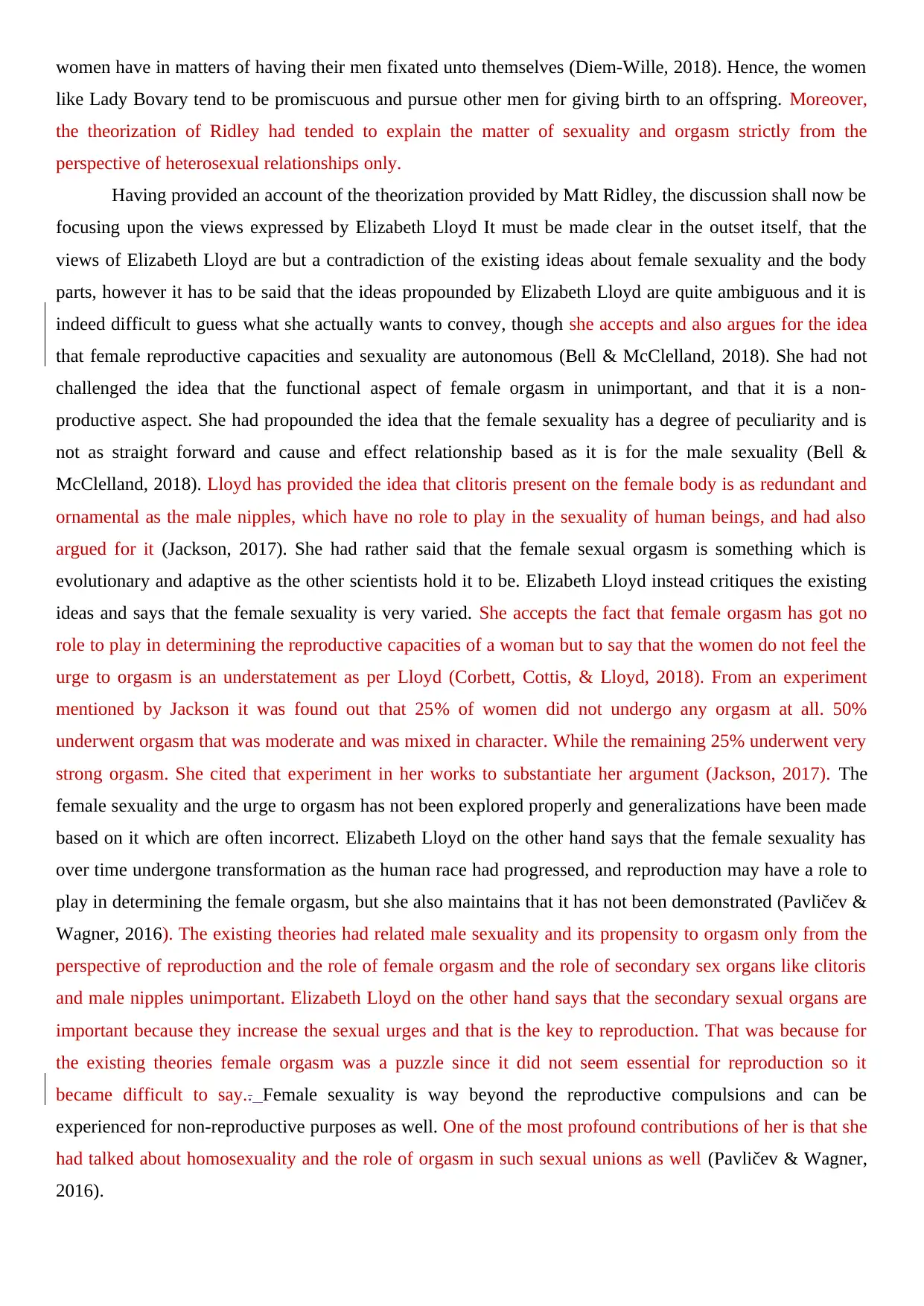
women have in matters of having their men fixated unto themselves (Diem-Wille, 2018). Hence, the women
like Lady Bovary tend to be promiscuous and pursue other men for giving birth to an offspring. Moreover,
the theorization of Ridley had tended to explain the matter of sexuality and orgasm strictly from the
perspective of heterosexual relationships only.
Having provided an account of the theorization provided by Matt Ridley, the discussion shall now be
focusing upon the views expressed by Elizabeth Lloyd It must be made clear in the outset itself, that the
views of Elizabeth Lloyd are but a contradiction of the existing ideas about female sexuality and the body
parts, however it has to be said that the ideas propounded by Elizabeth Lloyd are quite ambiguous and it is
indeed difficult to guess what she actually wants to convey, though she accepts and also argues for the idea
that female reproductive capacities and sexuality are autonomous (Bell & McClelland, 2018). She had not
challenged the idea that the functional aspect of female orgasm in unimportant, and that it is a non-
productive aspect. She had propounded the idea that the female sexuality has a degree of peculiarity and is
not as straight forward and cause and effect relationship based as it is for the male sexuality (Bell &
McClelland, 2018). Lloyd has provided the idea that clitoris present on the female body is as redundant and
ornamental as the male nipples, which have no role to play in the sexuality of human beings, and had also
argued for it (Jackson, 2017). She had rather said that the female sexual orgasm is something which is
evolutionary and adaptive as the other scientists hold it to be. Elizabeth Lloyd instead critiques the existing
ideas and says that the female sexuality is very varied. She accepts the fact that female orgasm has got no
role to play in determining the reproductive capacities of a woman but to say that the women do not feel the
urge to orgasm is an understatement as per Lloyd (Corbett, Cottis, & Lloyd, 2018). From an experiment
mentioned by Jackson it was found out that 25% of women did not undergo any orgasm at all. 50%
underwent orgasm that was moderate and was mixed in character. While the remaining 25% underwent very
strong orgasm. She cited that experiment in her works to substantiate her argument (Jackson, 2017). The
female sexuality and the urge to orgasm has not been explored properly and generalizations have been made
based on it which are often incorrect. Elizabeth Lloyd on the other hand says that the female sexuality has
over time undergone transformation as the human race had progressed, and reproduction may have a role to
play in determining the female orgasm, but she also maintains that it has not been demonstrated (Pavličev &
Wagner, 2016). The existing theories had related male sexuality and its propensity to orgasm only from the
perspective of reproduction and the role of female orgasm and the role of secondary sex organs like clitoris
and male nipples unimportant. Elizabeth Lloyd on the other hand says that the secondary sexual organs are
important because they increase the sexual urges and that is the key to reproduction. That was because for
the existing theories female orgasm was a puzzle since it did not seem essential for reproduction so it
became difficult to say.. Female sexuality is way beyond the reproductive compulsions and can be
experienced for non-reproductive purposes as well. One of the most profound contributions of her is that she
had talked about homosexuality and the role of orgasm in such sexual unions as well (Pavličev & Wagner,
2016).
like Lady Bovary tend to be promiscuous and pursue other men for giving birth to an offspring. Moreover,
the theorization of Ridley had tended to explain the matter of sexuality and orgasm strictly from the
perspective of heterosexual relationships only.
Having provided an account of the theorization provided by Matt Ridley, the discussion shall now be
focusing upon the views expressed by Elizabeth Lloyd It must be made clear in the outset itself, that the
views of Elizabeth Lloyd are but a contradiction of the existing ideas about female sexuality and the body
parts, however it has to be said that the ideas propounded by Elizabeth Lloyd are quite ambiguous and it is
indeed difficult to guess what she actually wants to convey, though she accepts and also argues for the idea
that female reproductive capacities and sexuality are autonomous (Bell & McClelland, 2018). She had not
challenged the idea that the functional aspect of female orgasm in unimportant, and that it is a non-
productive aspect. She had propounded the idea that the female sexuality has a degree of peculiarity and is
not as straight forward and cause and effect relationship based as it is for the male sexuality (Bell &
McClelland, 2018). Lloyd has provided the idea that clitoris present on the female body is as redundant and
ornamental as the male nipples, which have no role to play in the sexuality of human beings, and had also
argued for it (Jackson, 2017). She had rather said that the female sexual orgasm is something which is
evolutionary and adaptive as the other scientists hold it to be. Elizabeth Lloyd instead critiques the existing
ideas and says that the female sexuality is very varied. She accepts the fact that female orgasm has got no
role to play in determining the reproductive capacities of a woman but to say that the women do not feel the
urge to orgasm is an understatement as per Lloyd (Corbett, Cottis, & Lloyd, 2018). From an experiment
mentioned by Jackson it was found out that 25% of women did not undergo any orgasm at all. 50%
underwent orgasm that was moderate and was mixed in character. While the remaining 25% underwent very
strong orgasm. She cited that experiment in her works to substantiate her argument (Jackson, 2017). The
female sexuality and the urge to orgasm has not been explored properly and generalizations have been made
based on it which are often incorrect. Elizabeth Lloyd on the other hand says that the female sexuality has
over time undergone transformation as the human race had progressed, and reproduction may have a role to
play in determining the female orgasm, but she also maintains that it has not been demonstrated (Pavličev &
Wagner, 2016). The existing theories had related male sexuality and its propensity to orgasm only from the
perspective of reproduction and the role of female orgasm and the role of secondary sex organs like clitoris
and male nipples unimportant. Elizabeth Lloyd on the other hand says that the secondary sexual organs are
important because they increase the sexual urges and that is the key to reproduction. That was because for
the existing theories female orgasm was a puzzle since it did not seem essential for reproduction so it
became difficult to say.. Female sexuality is way beyond the reproductive compulsions and can be
experienced for non-reproductive purposes as well. One of the most profound contributions of her is that she
had talked about homosexuality and the role of orgasm in such sexual unions as well (Pavličev & Wagner,
2016).
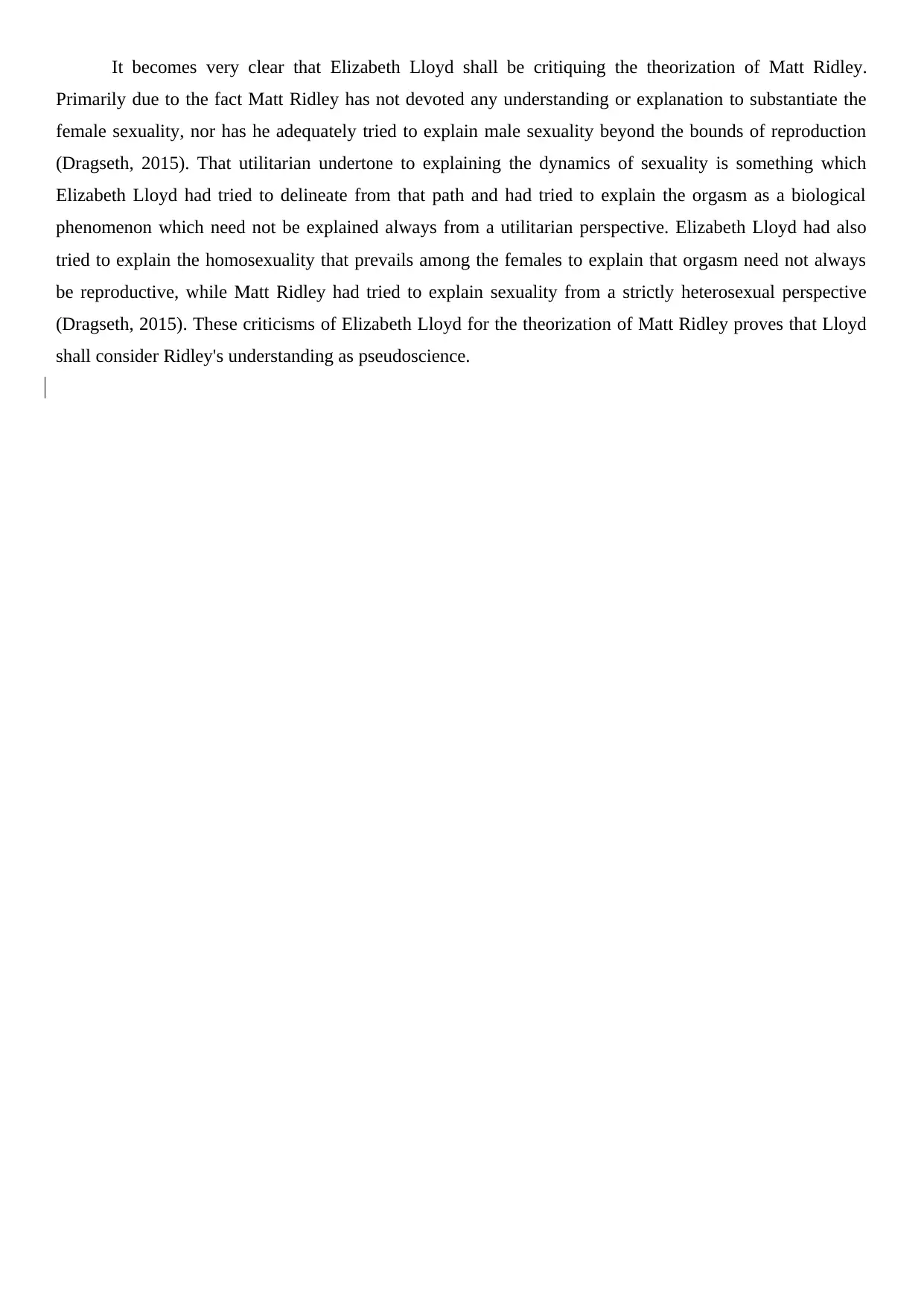
It becomes very clear that Elizabeth Lloyd shall be critiquing the theorization of Matt Ridley.
Primarily due to the fact Matt Ridley has not devoted any understanding or explanation to substantiate the
female sexuality, nor has he adequately tried to explain male sexuality beyond the bounds of reproduction
(Dragseth, 2015). That utilitarian undertone to explaining the dynamics of sexuality is something which
Elizabeth Lloyd had tried to delineate from that path and had tried to explain the orgasm as a biological
phenomenon which need not be explained always from a utilitarian perspective. Elizabeth Lloyd had also
tried to explain the homosexuality that prevails among the females to explain that orgasm need not always
be reproductive, while Matt Ridley had tried to explain sexuality from a strictly heterosexual perspective
(Dragseth, 2015). These criticisms of Elizabeth Lloyd for the theorization of Matt Ridley proves that Lloyd
shall consider Ridley's understanding as pseudoscience.
Primarily due to the fact Matt Ridley has not devoted any understanding or explanation to substantiate the
female sexuality, nor has he adequately tried to explain male sexuality beyond the bounds of reproduction
(Dragseth, 2015). That utilitarian undertone to explaining the dynamics of sexuality is something which
Elizabeth Lloyd had tried to delineate from that path and had tried to explain the orgasm as a biological
phenomenon which need not be explained always from a utilitarian perspective. Elizabeth Lloyd had also
tried to explain the homosexuality that prevails among the females to explain that orgasm need not always
be reproductive, while Matt Ridley had tried to explain sexuality from a strictly heterosexual perspective
(Dragseth, 2015). These criticisms of Elizabeth Lloyd for the theorization of Matt Ridley proves that Lloyd
shall consider Ridley's understanding as pseudoscience.
⊘ This is a preview!⊘
Do you want full access?
Subscribe today to unlock all pages.

Trusted by 1+ million students worldwide
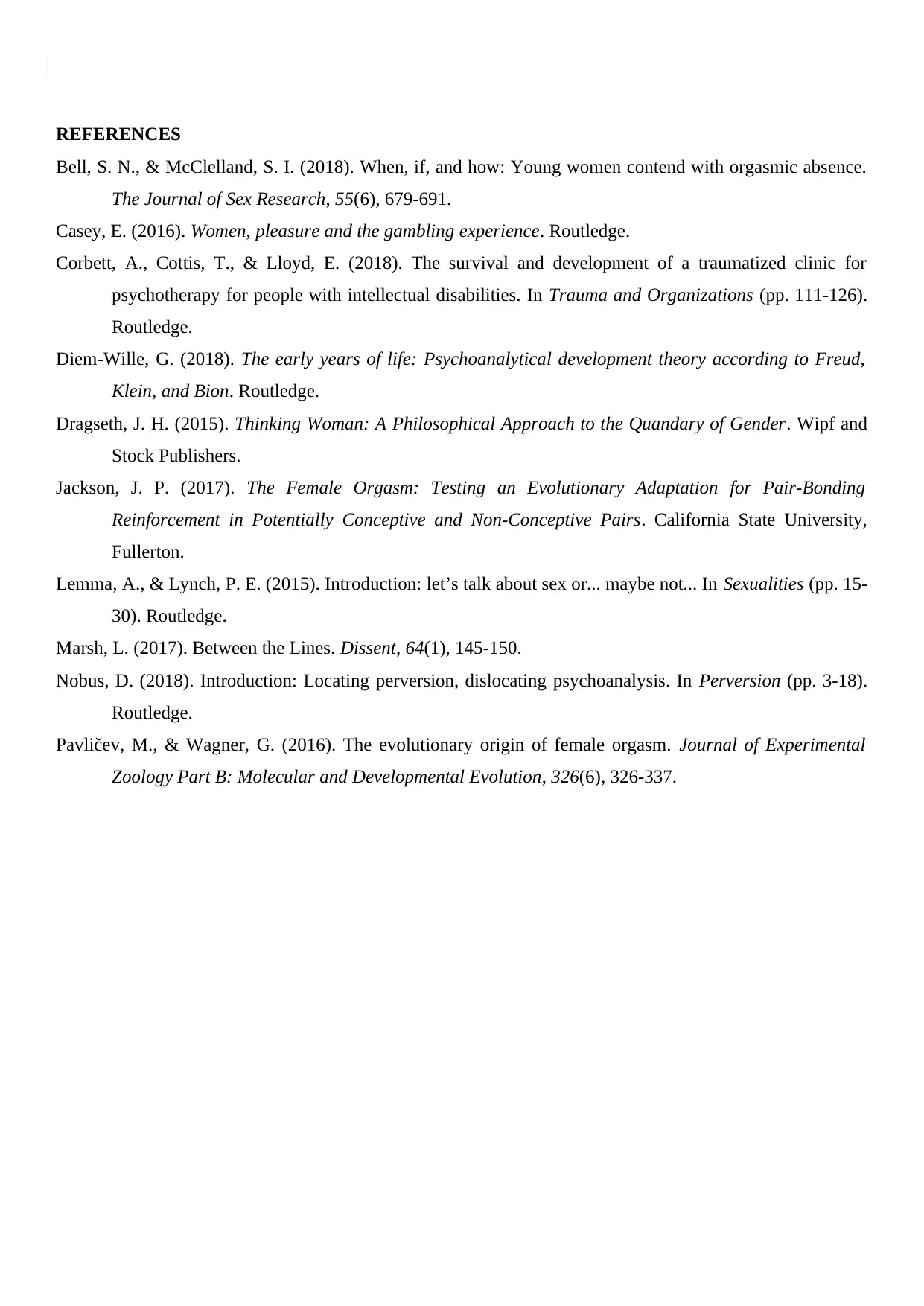
REFERENCES
Bell, S. N., & McClelland, S. I. (2018). When, if, and how: Young women contend with orgasmic absence.
The Journal of Sex Research, 55(6), 679-691.
Casey, E. (2016). Women, pleasure and the gambling experience. Routledge.
Corbett, A., Cottis, T., & Lloyd, E. (2018). The survival and development of a traumatized clinic for
psychotherapy for people with intellectual disabilities. In Trauma and Organizations (pp. 111-126).
Routledge.
Diem-Wille, G. (2018). The early years of life: Psychoanalytical development theory according to Freud,
Klein, and Bion. Routledge.
Dragseth, J. H. (2015). Thinking Woman: A Philosophical Approach to the Quandary of Gender. Wipf and
Stock Publishers.
Jackson, J. P. (2017). The Female Orgasm: Testing an Evolutionary Adaptation for Pair-Bonding
Reinforcement in Potentially Conceptive and Non-Conceptive Pairs. California State University,
Fullerton.
Lemma, A., & Lynch, P. E. (2015). Introduction: let’s talk about sex or... maybe not... In Sexualities (pp. 15-
30). Routledge.
Marsh, L. (2017). Between the Lines. Dissent, 64(1), 145-150.
Nobus, D. (2018). Introduction: Locating perversion, dislocating psychoanalysis. In Perversion (pp. 3-18).
Routledge.
Pavličev, M., & Wagner, G. (2016). The evolutionary origin of female orgasm. Journal of Experimental
Zoology Part B: Molecular and Developmental Evolution, 326(6), 326-337.
Bell, S. N., & McClelland, S. I. (2018). When, if, and how: Young women contend with orgasmic absence.
The Journal of Sex Research, 55(6), 679-691.
Casey, E. (2016). Women, pleasure and the gambling experience. Routledge.
Corbett, A., Cottis, T., & Lloyd, E. (2018). The survival and development of a traumatized clinic for
psychotherapy for people with intellectual disabilities. In Trauma and Organizations (pp. 111-126).
Routledge.
Diem-Wille, G. (2018). The early years of life: Psychoanalytical development theory according to Freud,
Klein, and Bion. Routledge.
Dragseth, J. H. (2015). Thinking Woman: A Philosophical Approach to the Quandary of Gender. Wipf and
Stock Publishers.
Jackson, J. P. (2017). The Female Orgasm: Testing an Evolutionary Adaptation for Pair-Bonding
Reinforcement in Potentially Conceptive and Non-Conceptive Pairs. California State University,
Fullerton.
Lemma, A., & Lynch, P. E. (2015). Introduction: let’s talk about sex or... maybe not... In Sexualities (pp. 15-
30). Routledge.
Marsh, L. (2017). Between the Lines. Dissent, 64(1), 145-150.
Nobus, D. (2018). Introduction: Locating perversion, dislocating psychoanalysis. In Perversion (pp. 3-18).
Routledge.
Pavličev, M., & Wagner, G. (2016). The evolutionary origin of female orgasm. Journal of Experimental
Zoology Part B: Molecular and Developmental Evolution, 326(6), 326-337.
1 out of 7
Related Documents
Your All-in-One AI-Powered Toolkit for Academic Success.
+13062052269
info@desklib.com
Available 24*7 on WhatsApp / Email
![[object Object]](/_next/static/media/star-bottom.7253800d.svg)
Unlock your academic potential
Copyright © 2020–2025 A2Z Services. All Rights Reserved. Developed and managed by ZUCOL.




